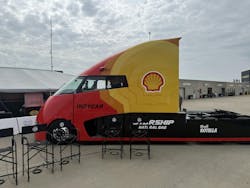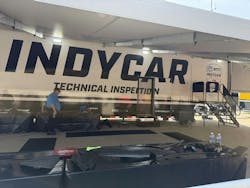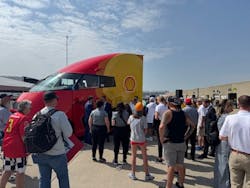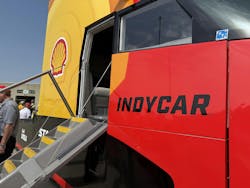Shell puts its Starship 3.0 to work for IndyCar
Key takeaways:
- Shell's Starship Project, which debuted its first Starship in 2018, announced the third-generation Starship, Starship 3.0, will haul the IndyCar Series' Pennzoil Tech Inspection trailer.
- Starship 3.0 features the Cummins X15N natural gas engine and is powered by renewable natural gas. NACFE's Mike Roeth said this allows the Class 8 truck to produce a negative carbon footprint.
- Starship 3.0 has achieved 9 mpg of diesel gallon equivalent and transported three times more freight per kilogram of CO2 emitted than the average transport truck, according to Shell.
- Now that the truck has been put to work, the real test begins.
The Starship’s road to 3.0
After its debut at TMC in 2018, the first-gen Starship went on a 2,300-mile cross-country test run from San Diego, California, to Jacksonville, Florida. The truck achieved an average mpg of 8.94 with a gross vehicle weight of nearly 73,000 lb., significantly better than the then-average U.S. fuel economy for transport trucks at 6.4 miles per gallon.
But Shell’s main focus was the Starship’s freight-ton efficiency, which measures efficiency by combining cargo weight with the fuel consumed. On its cross-country test run, the first-gen Starship achieved a freight-ton efficiency of 178.4, more than two times higher than the average Class 8 truck at 72 ton-miles per gallon.
Understanding that there’s always room for improvement, Shell announced the Starship 2.0 in 2021. The second generation featured a lighter-weight chassis, a new powertrain (a 2020 Cummins X15 engine paired with Eaton's Cummins Endurant 12-speed transmission), low rolling resistance tires, and a new harnessing system that enabled electrical systems to “all work in concert,” according to a FleetOwner article that covered the news.
On the Starship 2.0’s fully loaded cross-country run from San Diego to Jacksonville, the truck achieved a whopping 254 ton-miles per gallon and an average mpg of 10.8.
Now, the third-generation Starship is here and ready for work. It features the all-new Cummins X15N natural gas engine and has proven itself on the open road in test runs. The real test begins as Shell puts the Starship 3.0 to work hauling.
Shell debuted its first-generation Starship at the Technology & Maintenance Council’s annual meeting in 2018. Dubbed the “Starship Project,” the initiative sought to showcase how fleets can improve freight-ton efficiency using available technology.
As the years passed and technology progressed, Shell modified the Starship accordingly and deemed the latest iteration of the Starship ready for work.
What’s the Shell Starship?
Last fall, Shell showcased the third and latest iteration of the Starship, Starship 3.0, to a group of trucking media at Barber Motorsports Park and Museum in Alabama.
While the Starship 3.0 looks nearly identical to its predecessors on the outside, it’s what’s under the hood that makes all the difference. This latest version of the Starship features the new Cummins X15N natural gas engine, which Shell claims produces horsepower and torque similar to a diesel engine.
Before deciding on natural gas, the Starship Project team weighed different alternative fuel options, such as hydrogen, but ultimately decided on natural gas as it is something that “fleets can adopt now, instead of some future, far off ‘what if,’” Heather Duffey, global integrated communications manager for Shell Commercial Road Transport Lubricants, said at the event last fall.
See also: Shell launches Starship 3.0 with major efficiency gains in an ICE package
Though natural gas is less efficient than diesel, with its updated powertrain, the Starship 3.0 outperformed the first- and second-generation diesel-powered Starships in a demonstration run in California. The fully loaded truck, powered by renewable natural gas, achieved 9 mpg of diesel gallon equivalent and transported three times more freight per kilogram of CO2 emitted, according to a Shell press release.
The North American Council for Freight Efficiency has validated the data of each Starship run since 2018. Mike Roeth, executive director of NACFE, noted that when using renewable natural gas, the Starship 3.0 has a “negative carbon footprint" and praised its performance.
“I'm here to validate that this is probably the most efficient, best natural gas Class 8 truck in America—or maybe even the world,” Roeth said during Shell’s joint press conference with IndyCar in the infield of the Indianapolis Motor Speedway.
Putting the Starship to work
The Shell Starship Project team didn’t begin with a goal to put the truck to work, Thomas Mueller, general manager of Commercial Road Transport at Shell, said; however, the opportunity to haul freight for IndyCar was worth taking.
“Remember, this is the third version [of the Shell Starship], right? So, we were kind of thinking, ‘Well, what's next? What are we going to try next?’” Mueller told FleetOwner. “And this opportunity came up with NTT IndyCar Series, and it's like, ‘Hey, this is a great chance to see how it performs in real life.’”
None of the previous Shell Starship runs were staged, Mueller said, but he did describe them as a bit artificial.
“You know what the route’s going to be, your driver selection is important—all of that stuff plays into how you achieve those numbers,” Mueller said, referring to the Starship 3.0’s mpg and freight-ton efficiency data.
Yet with the Starship 3.0 running real routes for IndyCar, the Starship Project team will see if the experiment is much more than just that. With the Starship 3.0 at work, Shell will understand how real-world aspects—such as rain, wind, different routes, etc.—affect those high-efficiency numbers the truck has produced thus far.
See also: 3rd-gen Shell Starship posts big efficiency, emissions gains
So, why haul for the IndyCar Series?
Mueller said that while the opportunity was somewhat “happenstance,” it was actually many years in the making, citing the companies’ partnership over the years. (Shell is the official motor oil, lubricant, and fuel provider for the Indycar Series, providing 100% renewable racing fuel to the Series since 2023.)
“The predecessor to this version for a few months hauled our products between plants,” Mueller explained. Penske (IndyCar’s parent company) and IndyCar “knew about it from that. So that was maybe where the discussion started. It's been a number of years. Let's put it that way. It didn't happen overnight.”
IndyCar has worked to build its sustainability efforts over the years, and integrating the Shell Starship 3.0 into its logistics was a natural way to continue moving forward with its mission.
“It's our job to use the platform we have to talk more and more about how we can be sustainable in everything we do,” Doug Boles, president of IndyCar and Indianapolis Motor Speedway, said at the press conference. “When you can take a product like Starship 3.0 with Shell, the Cummins engine that's in it, work with the folks like NTT and Shell, and pull our tech trailer down the road, it's a great example for us to talk about how we can prove out ways to be sustainable.”
FleetOwner toured the Pennzoil Tech Inspection Trailer to be hauled by Starship 3.0. The 53-ft. trailer, split into a stacked first and second floor, houses office space and storage for the IndyCar tech inspection team tasked with inspecting each Indy car before every series race.
The Pennzoil Tech Inspection Trailer is present at each race, and the Starship’s first trip with the trailer will be to the Detroit Grand Prix the weekend of June 1.
The Starship’s fleet future
It’s likely that any truck enthusiast will be happy to see this truck hauling real freight on real routes. Its futuristic and otherworldly appearance has caused a stir wherever it goes. But Mueller said that even with Starship 3.0’s success, don’t expect to see a fleet of Starships anytime soon.
He does expect, however, to see some of the truck’s aspects adopted by other fleets. While redesigning the cabs of Class 8 trucks to resemble the bullet design of the Shell Starship isn’t feasible—not to mention the cost of the carbon fiber material alone—Mueller pointed to some of the truck’s aerodynamic features that can be implemented into current fleets today. Of course, he also mentioned the truck’s fluids.
Starship 3.0 uses a Shell specially designed low-viscosity 5W-30 natural gas engine oil, which “years ago, no one put a 5W-30 in a Class 8 truck,” Mueller said. “Now 10W-30 is definitely the standard for most professional fleets ... That lower viscosity is helping your fuel economy. You just have to get the right one so that it actually does the protection job that is supposed to do.”
Seven years since the Starship’s first launch, the truck has gone from being a project to working in the field—a testament to the industry’s dedication to increasing efficiency. If Starship 3.0 hauls the tech trailer successfully for the remainder of the 2025 IndyCar Series, the industry might see similar design aspects making their way into future Class 8 trucks. But for now, roll on, Starship 3.0.
About the Author
Jade Brasher
Senior Editor Jade Brasher has covered vocational trucking and fleets since 2018. A graduate of The University of Alabama with a degree in journalism, Jade enjoys telling stories about the people behind the wheel and the intricate processes of the ever-evolving trucking industry.





